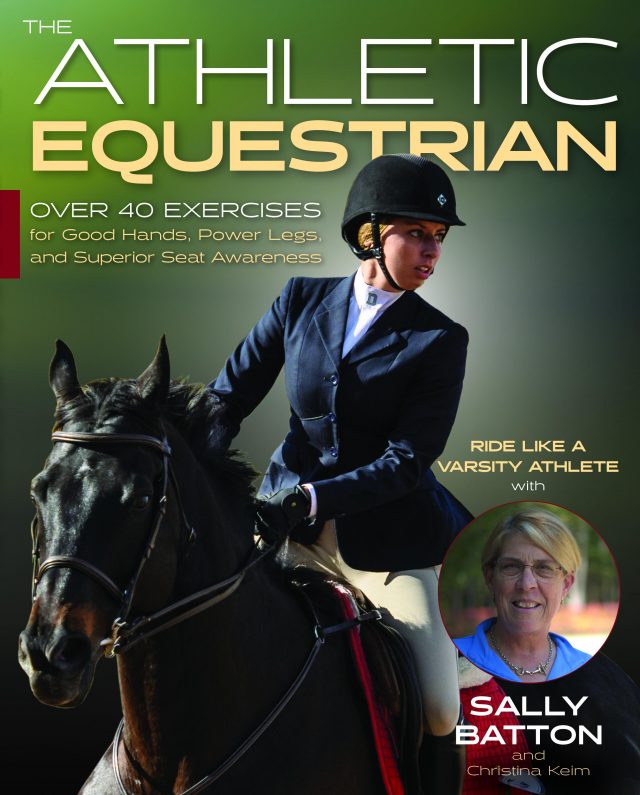
Athletic Equestrian Hack: Fix Those Slumped Shoulders!
In this excerpt from her new book The Athletic Equestrian, long-time collegiate coach Sally Batton gives us one of her cool teaching tools for improving our upper-body position in the saddle.

Riding in balance with the horse is all about alignment—the rider is responsible for centering her body over the horse’s center of gravity at all gaits on the flat and during all phases of the jumping effort. A rider in correctly maintained alignment is supporting the horse rather than impeding his forward motion and impulsion.
In my experience, learning to feel correct upper body posture is one of the hardest concepts for a rider to master if she doesn’t have someone watching her all the time. Rounded, slumped, or rolled-over shoulders are among the most common equitation faults, yet most riders have no idea they are holding their bodies incorrectly. In particular, many riders lose their upper body alignment completely in both upward and downward transitions. Unfortunately, correct posture is simply one of the hardest qualities for riders to feel on the horse. Until correct posture becomes your habit, you will need to concentrate on improving your posture every time you ride.
Most of us didn’t attend etiquette classes growing up, where we would have learned to sit and walk elegantly with a perfectly straight back. In addition, we spend an ever-increasing amount of time at a desk or working over a computer, which can encourage rounded shoulders if you don’t choose to hold them differently. The fact is that many riders climb into the saddle almost primed to ride with their shoulders slumped. This incorrect posture has immediate and significant negative impacts on the balance of both horse and rider and the effectiveness of the rider’s aids.
Riding with rounded shoulders causes the rider’s upper body to lean too far forward, burdening the horse’s forehand. Rounded shoulders will also reduce the ability of her elastic, following elbow to maintain a soft connection with the horse’s mouth. In addition, nine times out of 10, a rider with rounded shoulders will also have a dropped head. Your head weighs between 8 and 10 pounds, and that is plenty of extra burden to further disrupt the horse’s natural balance.
I have been riding horses most of my life and use my aids so instinctively that I can’t always remember what it felt like when I was first learning. In order for me to keep my teaching skills fresh and on point, I enjoy trying new sports or activities that I’ve never done before. One year, I took advantage of free rowing lessons from the Dartmouth Outing Club. In order to row my single scull boat effectively, I was to round my back all the way forward, then lie all the way back as I pulled on the oars. I thought I was doing a pretty good job but my boat wasn’t making much progress. My coach kept telling me that I had to round my back over; I felt that I couldn’t possibly round it any more than I was already doing. As it turns out, my lifelong practice of maintaining correct upper-body posture for riding made it incredibly difficult for me to round my shoulders and spine forward, even on purpose!
I share this specific experience with you because it brings up several important principles.
First, it reminds me how hard it is to learn a new skill or movement, and motivated riders of all levels are learning new skills and movements nearly every lesson. Secondly, despite our best efforts, habits from other aspects of our lives will impact us as we are trying to learn these new skills and movements. Finally, it is yet another example of how our own perception of what our bodies are doing may not match what is actually happening; developing body awareness of how it feels to execute a movement correctly is key to being able to repeat it.
Learning to ride with correct upper body posture means that the rider has chosen to practice a different habit, one where she is able to keep her shoulders stacked over her hips. To help install this kinesthetic awareness, I use one of my Teaching Tools: Flat-Back Roll-Ups (make your own by rolling up a pair of slender magazines as tightly as you can so there is no light through the tube and secure them with packing tape).
Exercise: Using Flat-Back Roll-Ups for Posture Correction

Photo by Amanda Terbrusch
- Place one Flat-Back Roll-Up under each armpit, centering it so that about the same amount of Roll-Up protrudes on each side of your shoulder.
- Position the Roll-Up so that the front end is angled slightly upward, about 30 degrees. In order to maintain the Roll-Up in this position, you will need to engage the muscles of the upper back, which will pull your shoulders back, down, and into correct alignment.
- Start at the walk, until you get used to the feeling of the Roll-Ups, then move on to the trot and canter. Usually, riders can monitor the angled end of the Roll-Up from the corners of their eyes, ensuring that their upper bodies are maintaining the correct position. But not to worry—if you stop using the upper back muscles to support your correct shoulder posture, your Roll-Ups will start to slide down the arm until they fall out or you are holding them with your elbows. When this happens, stop, reset, then get back to practicing.
This excerpt from The Athletic Equestrian by Sally Batton and Christina Keim is reprinted with permission from Trafalgar Square Books. You can purchase The Athletic Equestrian here.






